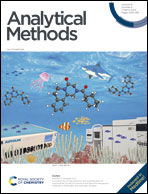A rapid and sensitive ultra-performance liquid chromatography-tandem mass spectrometry method for determination of phytohormones in the medicinal plant saffron
Abstract
Saffron (Crocus sativus L.) is a valuable Chinese herb with high medicinal value. Saffron pistils are used as medicine, so increasing the number of flowers can increase the yield. Plant hormones have essential roles in the growth and development of saffron, as well as the response to biotic and abiotic stresses (especially in floral initiation), which may directly affect the number of flowers. Quantitative analysis of plant hormones provides a basis for more efficient research on their synthesis, transportation, metabolism, and action. However, starch (which interferes with extraction) is present in high levels, and hormone levels are extremely low, in saffron corms, thereby hampering accurate determination of plant-hormone levels in saffron. Herein, we screened an efficient and convenient pre-treatment method for plant materials containing abundant amounts of starch. Also, we proposed an ultra-performance liquid chromatography-tandem mass spectrometry (UPLC-MS/MS) method for the quantification of abscisic acid (ABA) and auxin (IAA). Then, the method was applied for the detection of hormone-content differences between flowering and non-flowering top buds, as well as between lateral and top buds. Our method showed high sensitivity, reproducibility, and reliability. Specifically, good linearity in the range 2–100 ng ml−1 was achieved in the determination of ABA and IAA, and the correlation coefficient (R2) was >0.9982. The relative standard deviation was 2.956–14.51% (intraday) and 9.57–18.99% (interday), and the recovery range was 89.04–101.1% (n = 9). The matrix effect was 80.38–90.50% (n = 3). The method was thoroughly assessed employing various “green” chemistry evaluation tools: Blue Applicability Grade Index (BAGI), Complementary Green Analytical Procedure Index (Complex GAPI) and Red Green Blue 12 Algorithm (RGB12). These tools revealed the good greenness, analytical performance, applicability, and overall sustainability alignment of our method. Quantitative results showed that, compared with saffron with a flowering phenotype cultivated at 25 °C, the contents of IAA and ABA in the terminal buds of saffron cultivated at 16 °C decreased significantly. When cultivated at 25 °C, the IAA and ABA contents in the terminal buds of saffron were 1.54- and 4.84-times higher than those in the lateral buds, respectively. A simple, rapid, and accurate UPLC-MS/MS method was established to determine IAA and ABA contents. Using this method, a connection between the contents of IAA and ABA and the flowering phenotype was observed in the quantification results. Our data lay a foundation for studying the flowering mechanism of saffron.



 Please wait while we load your content...
Please wait while we load your content...